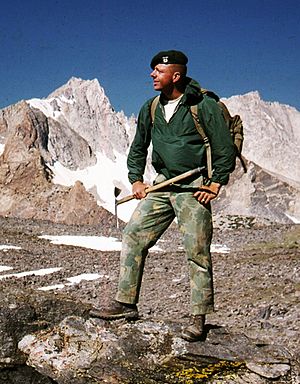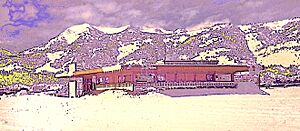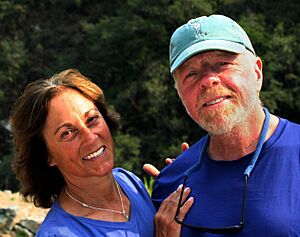Vince Lee (explorer) facts for kids
Quick facts for kids
Vince Lee
|
|
|---|---|

Lee in 1963
|
|
| Born | November 7, 1938 Gainesville, Florida, U.S.
|
| Died | April 17, 2024 (aged 85) Cortez, Colorado, U.S.
|
| Education | Princeton University, B.A, 1960; MFA 1966 |
| Known for | Mountaineering; Inca explorations; megalith manipulator |
| Spouse(s) | Danielle F. Hayn (1961–78), Nancy Lee (née Goodman) (m. 1983) |
| Children | 3 |
Vincent "Vince" Richards Lee (November 7, 1938 – April 17, 2024) was an American writer and adventurer. He was a Marine Corps officer and a skilled mountaineer. Vince Lee also became a home designer, an explorer of ancient Inca sites, and a scholar who studied huge stone structures. He wrote several books about his adventures and discoveries.
Contents
Early Life and Education
Vince Lee was born in Gainesville, Florida, in 1938. He grew up in New York with his older brother. His father managed movie theaters for Paramount Pictures.
Vince went to North Tarrytown High School. Then he chose Princeton University and joined a military training program. He studied architecture and graduated in 1960. After college, he became a Second Lieutenant in the U.S. Marine Corps. He married Danielle Hayn in 1961, and they had three sons. They later divorced in 1977.
Marine Corps Service
Lee served with the 3rd Marine Division in places like Okinawa, the Philippines, and South Korea. With one year left in his service, he moved to the Marine Corps Mountain Warfare Training Center (MWTC) in California. After finishing the training, he became an instructor there.
Vince Lee used his knowledge of civilian climbing to improve the school's methods. He introduced new climbing techniques and lighter gear. The Marine Corps history of the MWTC praised his work. They said he "skillfully modernized the syllabus" of their mountain training. A future Marine General even called him a "superb mountain leader."
Mountaineer and Teacher
After leaving the Marines, Vince Lee started working with the Outward Bound program. This program teaches outdoor skills and teamwork. He became a mountaineering instructor in Colorado.
Later, Lee and a friend, Jim Hollandsworth, led mountain expeditions for the Asheville School. While working as an architect, Lee turned this program into 'High Country West (HCW), Wilderness Expeditions'. For 23 years, he led many trips each summer. He taught climbing to hundreds of beginners. They explored nearly 500 peaks in the Rocky Mountains, Canada, and other countries. These trips ranged from easy outings to very challenging climbs.
Architect and Environmentalist
Vince Lee earned his master's degree in architecture from Princeton in 1966. For his final project, he designed a building for the North Carolina Outward Bound School. His design was well-received.
In 1966, Lee moved his family to Asheville, North Carolina, to work on the school's building plans. However, the project was canceled. In 1967, Lee moved west to Jackson Hole, Wyoming, to find work. He worked for a local architect who designed the Jackson Hole Mountain Resort.
Later, Lee and a colleague formed their own design company, Design Associates, Architects. When his partner retired, Lee became the sole owner. In 1968, he built his first house in Jackson Hole.
Lee also became an active environmentalist. He was appointed to Wyoming's Air Quality Advisory Board. He served on the Wyoming Environmental Quality Council for three terms. He also helped start and chaired the Jackson Hole Land Trust. When he moved to Cortez, Colorado, he continued his environmental work. He chaired the Montezuma Land Conservancy, which protects land in the Four Corners area.
In 1998, Lee retired and passed his architectural firm to his son, Christopher.
Andean Explorer
In 1983, Vince Lee married Nancy Goodman, who was also an outdoor instructor. She had been a Peace Corps volunteer in Peru.
In 1979, Lee went on an expedition to Colombia. He said he fell "under the spell of the Andes" mountains. Spending a month with the Kogi Indians sparked his interest in ancient societies. His love for buildings led him to study Andean archaeology.
Lee's journey to discovering Inca sites began when he read a book by explorer Gene Savoy. In 1982, Lee and two friends went to Peru to find a legendary mountain mentioned by Savoy. This mountain overlooked the ruins of Espíritu Pampa (the Plain of Ghosts). This site had been visited by Savoy and Hiram Bingham III, who "discovered" Machu Picchu.
Lee and his friends spent three weeks on their first trip. They found the huge granite peak and were the first known people to climb it. Local Indians called it Icma Colla, the Widowed Queen.
Savoy believed Espíritu Pampa was the last capital of the Inca Empire. For many years, Vilcabamba was not well known. Vince Lee's later explorations proved that Espíritu Pampa was indeed the final Inca capital. It was where the last Inca ruler, Tupac Amaru, lived. Lee dedicated his book to Tupac Amaru.
How They Explored
The Lees traveled lightly with only backpacks. This allowed them to explore parts of the Peruvian Andes that were hard to reach. They found, explored, and mapped every known archaeological site in Vilcabamba. They even discovered new ones. John Hemming, a famous historian, wrote that Lee's expeditions left "no doubt whatsoever" that Espíritu Pampa was the last Inca capital.
Lee's work was recognized by John Howland Rowe, a professor of archaeology. Rowe nominated Lee to join the Institute of Andean Studies. Lee presented papers at 24 annual meetings and published articles in the institute's journal. His work has been used by many other scholars.
Southwest Archaeologist
In 1998, the Lees retired to the Four Corners area of southwest Colorado. This region is surrounded by ancient Pueblo archaeological sites. Lee became interested in the 'Great Houses' of Chaco Canyon. He wrote a book comparing the 'Chaco Phenomenon' to the Inca Empire.
Lee also studied how ancient people quarried, moved, and built huge stone structures. He wrote about his findings in his book Ancient Moonshots. He also published a collection of papers called Building Big.
Some of his projects were shown on the History and Discovery Channels. Two were featured on NOVA television shows. One showed how the Incas fit huge boulders together in the walls of Sacsayhuamán, a fortress above Cuzco, Peru. Lee's method for this was published in a journal and updated in his book.
His other NOVA project was about the Rapanui people of Easter Island. He showed how they could have set up their giant moai statues. He described his solution for erecting El Gigante, the largest moai ever carved, in the Rapa Nui Journal.
Affiliations and Awards
Vince Lee was inducted into the Institute of Andean Studies in 1985. He was also a member of the American Alpine Club since 1970. Since 1990, he was a Fellow of the New York Explorers Club. He was also a research associate at the San Diego Museum of Man. Since 2000, he was a member and lecturer at the Stone Foundation in Santa Fe. He gave presentations at their events in 2000, 2003, 2005, and 2013.
Images for kids
-
Fellow Andeans; L to R: Hugh Thompson, John Hemming, Vince Lee, John Beauclerk in 2010.





